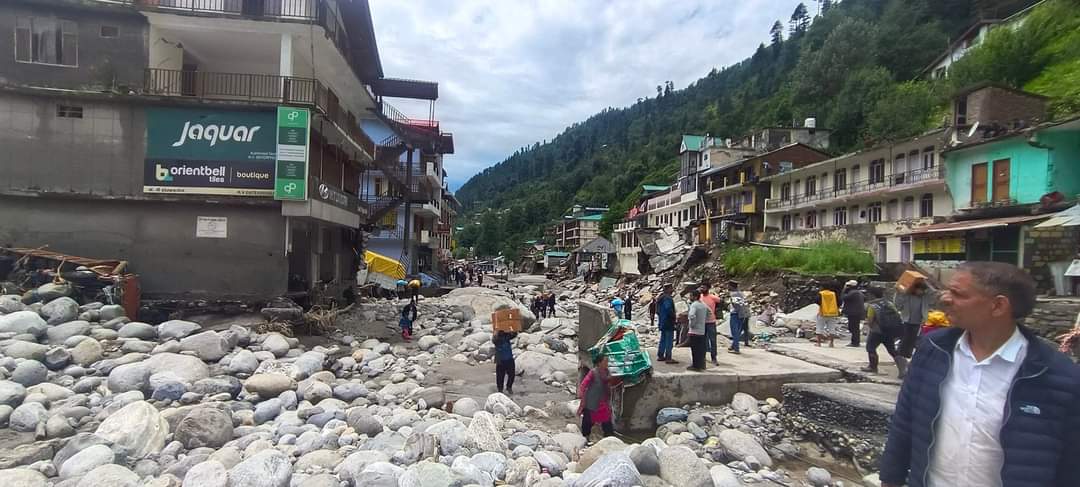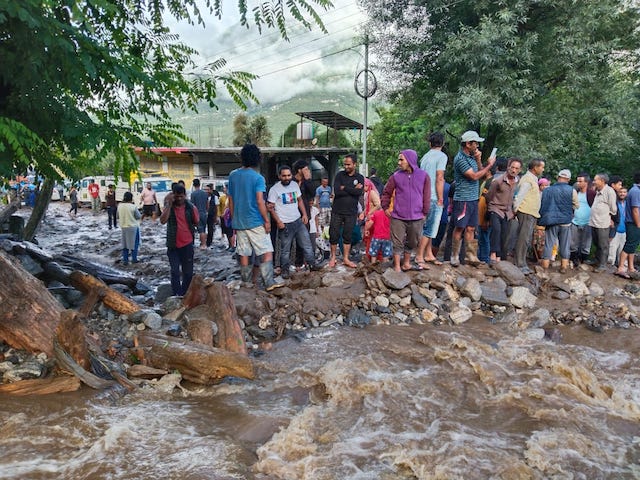It took Nature just one cataclysmic week in Himachal to reclaim the spaces which Man had been encroaching upon for decades, both in the river valleys and the mountain slopes. As the waters begin receding, they leave behind ample evidence of our hubris, stupidity and avarice.
Himachal has so far lost about 110 lives, dozens of vehicles ,hundreds of buildings and bridges, and many kilometres of roads. But one fact is clear- the maximum destruction of lives and public and private party has occurred in the river valleys of the Beas and Ravi, and along the two four laned arteries of the NHA- Parwanoo-Solan and Mandi-Manali. It is no coincidence that these are precisely the alignments where our policy makers have caused the maximum devastation of the environment.

Our anthropogenic footprints in these areas have been overwhelming, much more than what Nature can sustain and repair. Different digits of this footprint- illegal and legal mining, building construction on steep slopes and the rivers’ flood plains, hydel projects with their attendant blasting and muck dumping, road construction and widening, deforestation of thousands of trees- all these coalesced in this one week of July and triggered a reaction by the elements which should have been expected.
Environmentalists have long been warning the government of these consequence of its reckless degradation of the environment. The Shukla Committee report (commissioned by the High Court itself) of 2010 had called for a halt to hydel projects and for protection of the rivers, arguing that “there is no such thing as an environment-friendly hydel project.” Practical proof was provided, if proof was needed, by the devastation of Rishi Ganga and Uttarkashi. But our governments are nothing if not blind and deaf, and so all scientific and expert warnings were ignored, and life went on as usual in the interests of “tourism” and “development”.
Let us be clear about one thing: this month’s devastation is not due to climate change or extreme weather events- these have certainly amplified the problem but have not created them. They have been created by wrong policies, bad engineering, lax enforcement and criminal disregard of scientific principles and expert advice.
Much of the four laning of the Manali right bank road has been done ON THE RIVER BED of the Beas, as videos now show, by erecting retaining walls on the flood plains and filling them up. Where have the NHAI engineers got their degrees from, for God’s sake? Do they even have an idea of the destructive force of a mountain river cascading down in full flow, carrying huge boulders, trees and silt that will demolish anything in its path? Did they ever bother to study the history of the Beas and the damage it has caused in the past? Today, at least 6 kms of the four laning has been washed away, this road between Kullu and Manali will remain closed for months. It is significant to note that the only road still functional- the left bank road- is the road which the NHAI did not (thankfully) touch. Surely there’s a lesson for us here.

The four lane highway between Parwanoo and Dharampur also no longer exists: after spending Rs.4000 crores and ten years on converting a two lane into a four lane we are now left with the original two lane highway! The cause here is not a river but a mountain slope, and stupid engineering again. The original road was widened by cutting vertically into the mountain slopes, sometimes as much as 15 to 20 metres. One wonders whether the PWD and NHAI engineers had done their technical due diligence before letting loose their machines on this portion of the Himalayas. Did they, for instance, study the geomorphology of the mountains? Carry out tests to determine natural bulk density, soil resistivity, bearing capacity of the soil? Did they do a hydrometer analysis and sieve analysis of the soil to determine the water absorbing capability of the soil? Did they take adequate steps such as rock concreting and anchor bolting to stabilise the excavated portions of the slopes? The extent of the damage would suggest that perhaps none of this was done and so here also the four laning is just a memory now. More public money down the drain, along with thousands of tonnes of muck and rocks. We hope the govt. will respond to some of the questions raised above, but I am not holding my breath.
This constant road construction has generated millions of tonnes of muck which has just been dumped into the rivers, raising their beds, constricting their width and reducing their carrying capacity. Just imagine, the Kiratpur-Manali four lane alone has 21 tunnels- where do you think all that excavated muck has gone? On paper they have been dumped in landfills, the enormous cost involved shown in estimates and paid to the contractors, but in fact they have been dumped in the nearest river or just rolled down the hill-side!
Enter illegal (and legal) mining and rampant construction of buildings on the river beds, which goes on unchecked everywhere. This, along with the muck dumping, results in the rivers changing course quite often: this phenomenon has been responsible for much of the damage along the Beas this time. This too is something our highway engineers neither anticipated nor planned for.

Hydel projects too have played their part in the destruction. They obstruct the natural flow of these rivers, allow the building up of muck and sediment, and then release them in a torrent when they open their floodgates- it is this, rather than just the waters, which cause the maximum damage, especially to buildings and bridges, on impact. These dams are touted as flood control mechanisms, but in fact the opposite is true, at least on mountain rivers. They retain vast volumes of water (which is their revenue generating inventory, after all) till the last moment; when they release these waters, the consequences downstream are cataclysmic: most of the flooding and destruction in Pandoh market and Mandi this time was caused by the opening of all five flood gates of the Pandoh dam.
As I write this, the full extent of the destruction is yet to be assessed. Restoration work shall start soon, and that is precisely what I am fearful of. More taxpayers’ money will be used to repeat the mistakes of the past. My most fervent hope and prayer is that we learn from this catastrophe and change our engineering, planning and ambitions- that we do not build again on the river beds, that we stop this four laning madness, that we stop the blasting, tunnelling and vertical cutting of mountain sides, that we start listening to the objections of the local populations and acknowledge their protests, that we put a moratorium on further hydel projects. Surely the government should be able to see the mathematics, if not the science and common sense, in what has just happened?- in just two weeks the state has suffered more revenue loss than what it can earn in years. Yes, climate change is aggravating the severity of EWEs, but that is precisely why we should be changing our paradigms of “development” to a more sustainable model. Climate change should be a trigger for change, not an excuse for justifying our past (and continuing) mistakes. It’s more than time to stop this cycle of stupidity from playing out again and again every few years. Nature has started reclaiming what was always rightfully hers. Respect that and do not provoke her again.
PS
[NATURE RECLAIMS HER OWN – This blog was published in OUTLOOK (outlookindia.com) on 20.7.2023]
| The author retired from the IAS in December 2010. A keen environmentalist and trekker he has published a book on high altitude trekking in the Himachal Himalayas: THE TRAILS LESS TRAVELLED.
His second book- SPECTRE OF CHOOR DHAR is a collection of short stories based in Himachal and was published in July 2019. His third book was released in August 2020: POLYTICKS, DEMOCKRAZY AND MUMBO JUMBO is a compilation of satirical and humorous articles on the state of our nation. His fourth book was published on 6th July 2021. Titled INDIA: THE WASTED YEARS , the book is a chronicle of missed opportunities in the last nine years. Shukla’s fifth book – THE DEPUTY COMMISSIONER’S DOG AND OTHER COLLEAGUES- was released on 12th September 2023. It portrays the lighter side of life in the IAS and in Himachal. He writes for various publications and websites on the environment, governance and social issues. He divides his time between Delhi and his cottage in a small village above Shimla. He blogs at http://avayshukla.blogspot.in/ |



Dear Mr.shukla ,
The piece is word by word rightly said.I don’t understand why authorities can’t see it when common man can.
World famous Amalfi coast has lot of tourism but one will not find a four lane road there. They do have single lanes and mange traffic by signal system.
The same signal system was there ages back on way to badrinath.
It’s not that Italians can cut the mountain and make road but they probably respect nature,and know it’s true nature.
Now that this destruction is in front of our eyes, there must be accountability for the faulty engineering, construction and disposal of construction muck that has been dumped in the rivers. Were these done under public private partnership? Who has gained out of this? Responsible people must pay for this wanton destruction. Very forcefully written Mr. Shukla. I too love our mountains and have been trekking since I was a kid. I now live abroad and there are tears in my eyes. Our engineers and policy makers should be sent for training to places like Canada, to learn how they maintain their environmental treasures despite huge natural climatic challenges.
I live on and off.. in the Himalayas … have been there for over 40 years. The hills are not what they were . I’m sad to say that the glint of moolah is visible in the hill folks eyes now … and that too is responsible for the mess ..as much as politicians and outsiders are…there has to be a way to regulate tourism. Case in point … Bhutan!
I agree with Avay Shukla on almost all his points. But the landslides on my orchard & around my house, my stone steps, thada, lawn, retaining walls, etc. were not due to any encroachment, hydel project, mining, blasting, muck dumping, road widening or blockage of natural water channels due to construction on my part. It was due to careless, reckless & negligent diversion of all the rain water from the school & mela ground above my house onto my property. For the last six years I have been writing to everyone from the Ministers in the Education & Public Works Department, MLAs, to the Panchayat Pradhan to set things right but everyone passes the buck. Now I feel scared each time it rains.